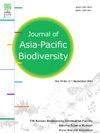New records of four introduced alien plants in coastal and port areas of South Korea
IF 0.7
Q4 BIODIVERSITY CONSERVATION
引用次数: 0
Abstract
We report the first confirmed records of four alien plants belonging to the families Poaceae, Cyperaceae, and Fabaceae in South Korea. Bromus rubens L. originated in the Mediterranean area and adjacent regions and was first discovered in the port area of Gunsan-si. This species is known as an invasive species in the Americas, Australia, parts of Europe, Japan, and Africa and is designated as an Alert Alien Species in Korea. Eriochloa contracta Hitchc., native to the United States, is classified as a weed harmful to crops and has been identified in an open area near the coast of Geoje-si. Carex oklahomensis Mack., which is indigenous to the central and eastern United States, was first identified in Sacheon-si, appearing to be the first recorded appearance in Asia. Finally, Chamaecrista nictitans (L.) Moench., a plant native to the Americas and introduced to Japan, was identified for the first time in Tongyeong-si. This study presents the distribution of introduced alien plants in Korea and provides information on their habitats and morphological details, accompanied with photographs. Additionally, this study establishes an important baseline for enhancing knowledge regarding alien plants primarily introduced through ports and coastal areas.
韩国沿海和港口地区四种引进外来植物的新记录
本文报道了在韩国首次发现的四种外来植物,它们分别属于禾本科、苏科和豆科。凤梨原产于地中海及周边地区,最早在群山市港口地区被发现。该物种在美洲、澳大利亚、欧洲部分地区、日本和非洲被称为入侵物种,在韩国被指定为警戒外来物种。黄斑挛缩。在巨济市海岸附近的开阔地带发现了原产于美国的杂草,被分类为对农作物有害的杂草。俄克拉荷马草。它原产于美国中部和东部,最初是在泗川市被发现的,似乎是在亚洲首次出现的记录。最后,Chamaecrista nictitans (L.)Moench。在统营市首次发现了原产于美洲并引进到日本的植物。本研究介绍了引进的外来植物在韩国的分布,提供了它们的栖息地和形态细节的信息,并附有照片。此外,本研究为加强对主要通过港口和沿海地区引进的外来植物的认识建立了重要的基线。
本文章由计算机程序翻译,如有差异,请以英文原文为准。
求助全文
约1分钟内获得全文
求助全文
来源期刊

Journal of Asia-Pacific Biodiversity
Agricultural and Biological Sciences-Insect Science
CiteScore
1.70
自引率
12.50%
发文量
94
审稿时长
27 days
期刊介绍:
The Journal of Asia-Pacific Biodiversity (previous title was Journal of Korean Nature) is an official journal of National Science Museum of Korea (NSMK) and Korea National Arboretum (KNA). The scope of journal is wide and multidisciplinary that publishes original research papers, review articles, as well as conceptual, technical and methodological papers on all aspects of biological diversity-its description, analysis and conservation, and its application by humankind. This wide and multidisciplinary journal aims to provide both scientists and practitioners in conservation theory, policy and management with comprehensive and applicable information. However, papers should not be submitted that deal with microorganisms, except in invited paper. Articles that are focused on the social and economical aspects of biodiversity will be normally not accepted.
 求助内容:
求助内容: 应助结果提醒方式:
应助结果提醒方式:


